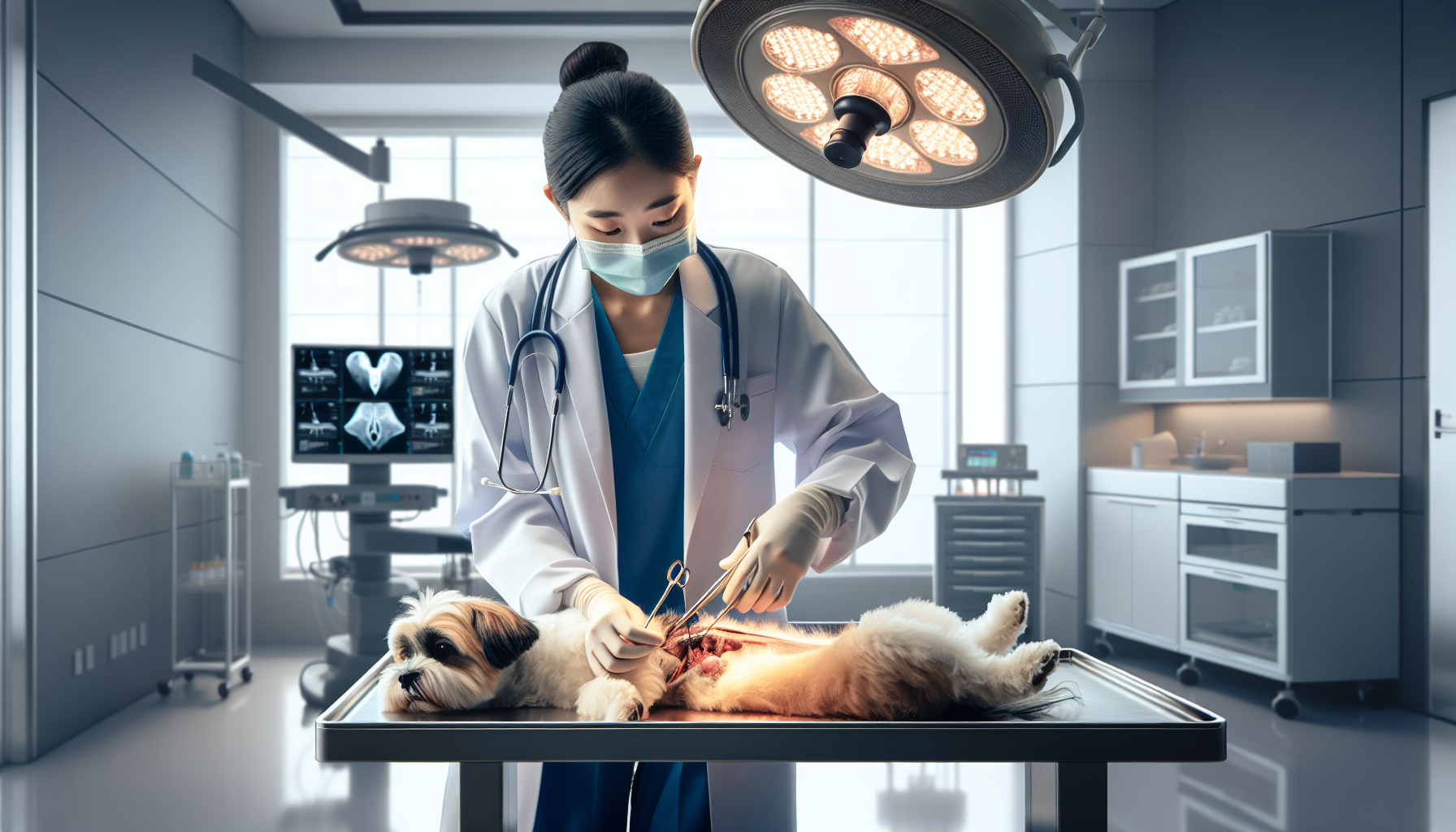In the pursuit of optimal care for your cherished animal companions, the search for a reputable veterinary surgery can be both urgent and overwhelming. “Animal Surgery Near Me” provides a critical resource, guiding you to select the finest local surgical options tailored to your pet’s unique medical needs. This article aims to equip you with pertinent information to make an informed decision, ensuring your beloved pet receives the highest standard of care during their most vulnerable moments.
Understanding Animal Surgery
As a pet owner, you’re invested in the well-being of your beloved animal companion. When surgery becomes a necessary part of their care, understanding the processes and procedures involved in animal surgery is imperative for you.
Common Types of Animal Surgeries
Animal surgeries can vary widely, ranging from routine elective procedures to intricate emergency operations. Some common surgeries include spaying and neutering, dental extractions, mass removals, fracture repair, and organ-specific procedures such as bladder stone removal or liver shunt repair. Each type is designed to improve or maintain the quality of life for animals.
Anesthetic Safety in Animal Surgery
Anesthesia is a critical component of most animal surgeries to ensure your pet doesn’t experience pain during the procedure. Veterinary teams assess the safety of anesthesia by considering the animal’s age, breed, and health status before selecting the most appropriate anesthetic protocol. Continuous monitoring during surgery helps manage any potential risks.
Pre-Surgical Assessments
Before the surgery, veterinarians perform comprehensive assessments, which may include blood tests, X-rays, ultrasounds, or other diagnostic procedures. These evaluations help determine the surgical risks and the best course of action for your pet.
Post-Surgery Care and Monitoring
Postoperative care is just as important as the surgery itself. It typically involves pain management, monitoring for complications, ensuring proper wound care, and sometimes administering antibiotics. Your veterinary team will provide instructions for home care, which you will need to follow closely to ensure a smooth recovery.
Finding a Veterinary Surgeon
Choosing the right veterinary surgeon is crucial. Their expertise directly impacts the success of the surgery and the health of your pet.
Qualifications of a Veterinary Surgeon
A qualified veterinary surgeon has completed years of education, including veterinary school and hands-on clinical training. They should have a Doctor of Veterinary Medicine (DVM) degree and a state license to practice veterinary medicine.
The Importance of a Board-Certified Surgeon
Board-certified surgeons have undergone additional specialty training and have passed rigorous exams administered by professional veterinary surgery boards. They are often preferred for complex procedures as their certification signifies a higher standard of surgical care.
Searching for the Right Veterinary Clinic or Hospital
When looking for “animal surgery near me,” you’ll want to evaluate the facilities in your area based on the qualifications of their staff, their surgical experience, the types of procedures they offer, and their emergency response capabilities. Recommendations from other pet owners or your primary veterinarian can also guide your choice.

Before the Surgery
Pre-surgical preparation is essential. It helps minimize risks and prepares you and your pet for the procedure.
Consultation and Diagnosis
Initially, your primary veterinarian will likely discuss the symptoms and medical history of your pet. They’ll conduct a thorough examination to reach a diagnosis that may lead to the recommendation for surgery.
Understanding the Costs
Understanding the financial aspect is important. Be sure to discuss with your veterinarian all the costs involved, including pre-surgical assessments, the surgery itself, anesthesia, postoperative care, and any follow-up appointments.
Pre-Surgery Instructions and Fasting
You will receive specific instructions based on the type of surgery your pet will undergo. Often, you will need to restrict food and water intake (fasting) for several hours before the procedure to reduce the risk of complications.
Consents and Paperwork
You will be asked to sign consent forms that explain the procedure and acknowledge the risks involved. Ensure that all of your questions are answered to your satisfaction before signing.
Types of Surgical Facilities
The chosen facility can have a significant impact on the surgery outcome due to differences in resources and expertise.
Specialized Animal Hospitals
These hospitals typically offer a wide range of surgical procedures with advanced equipment and specialists who can handle complex cases.
Mobile Veterinary Surgical Units
For areas lacking stationary veterinary hospitals or for pet owners unable to travel, mobile units can provide convenient surgical services with flexibility.
University Veterinary Teaching Hospitals
These hospitals are at the forefront of veterinary medicine and often feature cutting-edge technology and innovative surgical techniques, though they may also be part of the educational process for veterinary students.

Emergency Surgery
Recognizing and responding to an animal emergency can save your pet’s life.
Identifying an Animal Emergency
Signs such as profuse bleeding, severe injury, difficulty breathing, or sudden collapse warrant immediate attention. Quick identification and response are crucial.
Locating a 24/7 Emergency Veterinary Hospital
Knowing the location of emergency vet hospitals and their hours of operation is essential. Keep this information accessible in case of an emergency.
What to Expect During an Animal Emergency
In emergencies, time is of the essence. Veterinary teams will rapidly assess the situation and may need to perform lifesaving procedures on the spot. Your readiness to make quick decisions is paramount.
Elective Surgery
Unlike emergencies, elective surgeries are planned and can greatly benefit your pet’s quality of life.
Spay and Neuter Procedures
Spaying (for females) and neutering (for males) prevent unwanted litters and can help mitigate health risks, including certain types of cancers.
Dental Surgery for Animals
Dental surgeries, including teeth extractions, are commonly performed to address oral health issues that can affect your pet’s overall health.
Orthopedic Surgeries
Pets suffering from joint issues or bone injuries may require orthopedic surgeries, such as knee repairs or pinning of fractures, to restore mobility.
Postoperative Care
Post-surgery, attentive care is instrumental in ensuring a positive outcome.
Pain Management
Maintaining your pet’s comfort post-surgery typically involves medications and sometimes alternative therapies.
Infection Prevention
Follow your vet’s advice on keeping the surgical site clean and administering antibiotics as needed to prevent infection.
Wound Care
Proper wound care includes keeping the area clean, preventing your pet from licking or biting at the stitches or bandages, and monitoring for signs of healing.
Rehabilitation and Physical Therapy
Physical therapy can be crucial for recovery from orthopedic surgeries, helping to restore function and strength.
Special Considerations
Every pet is unique, and some may require special surgical considerations.
Dealing with Senior Pets
Older pets often have an increased risk for surgery, so a thorough pre-surgical assessment is vital to minimize complications.
Surgery for Brachycephalic Breeds
Breeds with short noses, like Pugs and Bulldogs, have distinct anatomical challenges that may complicate anesthesia and surgery.
Minimally Invasive Options
Whenever possible, veterinarians may opt for minimally invasive techniques, such as laparoscopy, which can lead to quicker recoveries and reduced pain.
What to Expect During Recovery
A successful recovery is a gradual process that requires patience and vigilance.
Typical Recovery Timelines
Understand that recovery times vary based on the procedure and each individual animal. Your vet will provide an estimated timeline.
Monitoring for Complications
Keep a close eye on your pet for any signs of complications such as excessive swelling, redness, or discharge from the incision site.
Modification of Home Environment
Creating a safe, quiet, and comfortable recovery area free of hazards can help facilitate healing.
Innovations in Veterinary Surgery
Veterinary medicine is constantly evolving, bringing advancements that improve surgical outcomes.
Advancements in Surgical Techniques
From new suture materials to less invasive procedures, ongoing research and development continue to refine surgical techniques.
Role of Technology in Animal Surgery
Emerging technologies, such as 3D printing for surgical planning and regenerative medicine, are shaping the future of veterinary surgery.
Future of Veterinary Surgery
Ongoing innovation promises even more precise, efficient, and successful surgical interventions for animals, ensuring they receive the best care possible.
from Elite Charleston Vets https://elite-charleston-vets.com/animal-surgery/animal-surgery-near-me/
via IFTTT
from Elite Charleston Vets https://elitecharlestonvets0.blogspot.com/2024/01/animal-surgery-near-me.html
via IFTTT
from Elite Charleston Vets https://elitecharlestonvets.wordpress.com/2024/01/31/animal-surgery-near-me/
via IFTTT
from Bonnie Linares https://bonnielinares.blogspot.com/2024/01/animal-surgery-near-me.html
via IFTTT
from
https://bonnielinares0.wordpress.com/2024/01/31/animal-surgery-near-me/




